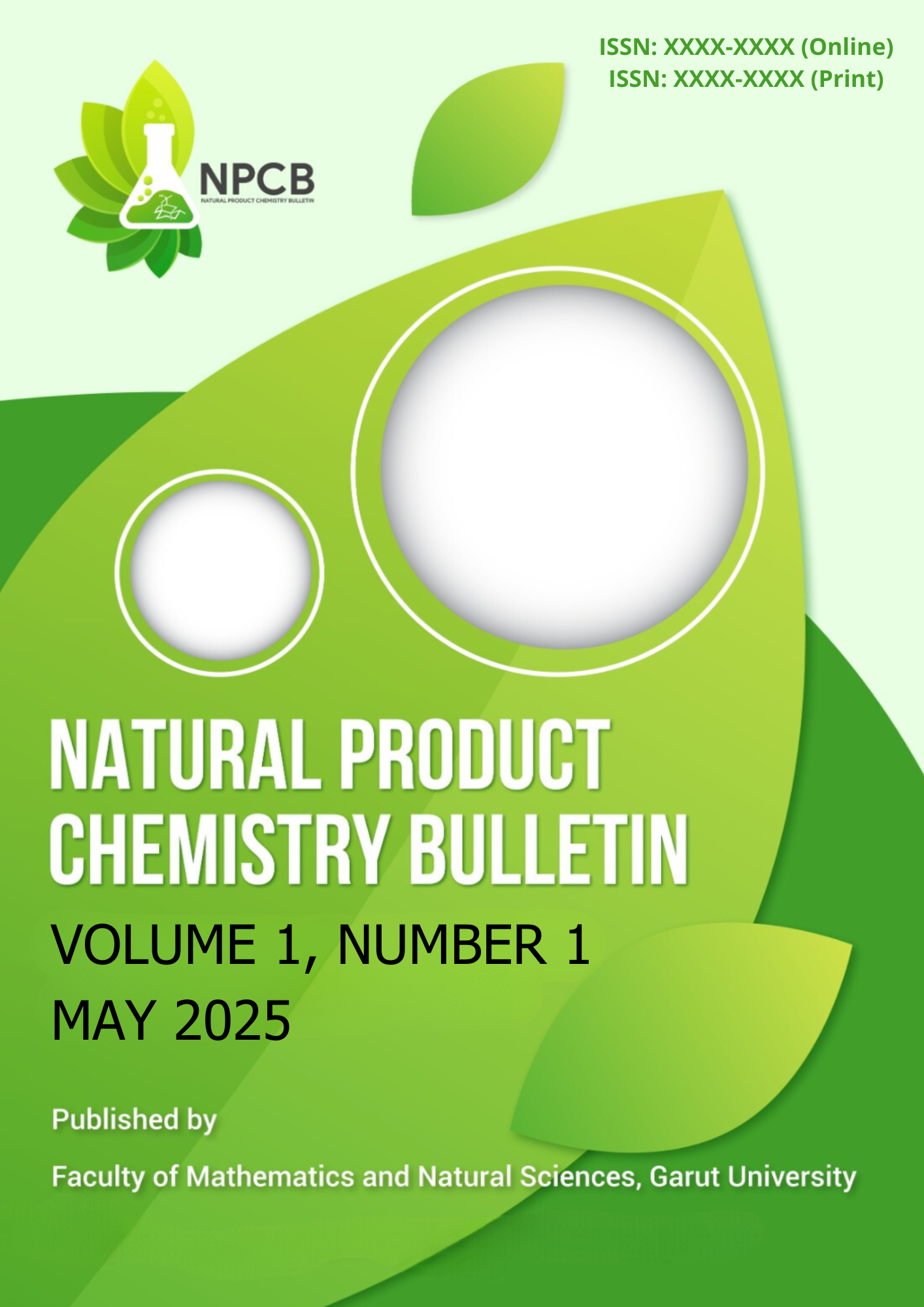Rapid Mixing Synthesis of Polyaniline as an Adsorbent for Cr(VI) Ions
Bahasa Indonesia
DOI:
https://doi.org/10.52434/npcb.v1i1.42458Keywords:
adsorbent, ammonium persulfate, chromium-metal ion, polyaniline, rapid mixingAbstract
The study of variations in the concentration of ammonium persulfate (APS) in the synthesis of polyaniline (PANI)
using the rapid mixing method aims to determine the best candidate for chromium metal ion adsorbents among the
PANI produced by varying the APS concentration. The variations in the APS concentration used were 0.1 M, 0.3 M,
0.5 M, and 0.7 M. The synthesized material was characterized using Fourier-transform infrared (FTIR) and Raman
spectroscopy, while particle morphology and size were assessed through scanning electron microscopy (SEM). The
results confirmed that the PANI produced was in the form of Emeraldine Salt (ES), with PANI 0.7 M yielding the
highest mass of 3.03 grams and exhibiting globular particles ranging from 75 to 106 nm and a significant chromium
(VI) ion adsorption capacity of 14.22 mg/g. These findings indicate that synthesizing PANI at an APS concentration
of 0.7 M is highly effective for creating nano-sized PANI with excellent adsorption properties. This material shows
great potential for use in water treatment applications related to leather tanning and as a counter electrode in dye-
sensitized solar cells, thereby highlighting the broader impact of the research.
References
Amalina, A. N., Suendo, V., Reza, M., Milana, P., Sunarya, R. R., Adhika, D. R., & Tanuwijaya, V. V. (2019). Preparation of Polyaniline Emeraldine Salt for Conducting-Polymer-Activated Counter Electrode in Dye Sensitized Solar Cell (DSSC) using Rapid-Mixing Polymerization at Various Temperature. Bulletin of Chemical Reaction Engineering &Amp; Catalysis, 14(3), 521. https://doi.org/10.9767/bcrec.14.3.3854.521-528
C. Gomes, E., & A. S. Oliveira, M. (2012). Chemical Polymerization of Aniline in Hydrochloric Acid (HCl) and Formic Acid (HCOOH) Media. Differences Between the Two Synthesized Polyanilines. American Journal of Polymer Science, 2(2), 5–13. https://doi.org/10.5923/j.ajps.20120202.02
Ding, J., Pu, L., Wang, Y., Wu, B., Yu, A., Zhang, X., Pan, B., Zhang, Q., & Gao, G. (2018). Adsorption and Reduction of Cr(VI) Together with Cr(III) Sequestration by Polyaniline Confined in Pores of Polystyrene Beads. Environmental Science and Technology, 52(21), 12602–12611. https://doi.org/10.1021/acs.est.8b02566
Eskandari, E., Kosari, M., Davood Abadi Farahani, M. H., Khiavi, N. D., Saeedikhani, M., Katal, R., & Zarinejad, M. (2020). A Review on Polyaniline-Based Materials Applications in Heavy Metals Removal and Catalytic Processes. Separation and Purification Technology, 231(August 2019). https://doi.org/10.1016/j.seppur.2019.115901
Fauziah, N., Khasannah, W. L., Andari, G. A., Fatya, A. I., Benu, D. P., Steky, F. V., Milana, P., Hidayat, R., & Suendo, V. (2023). Eco-friendly Direct-current Pulsed Electropolymerization of Polyaniline Nanofibers on Synthetic Graphite Substrate for Counter Electrode in Dye-Sensitized Solar Cells. Polymer-Plastics Technology and Materials, 62(6), 800–815. https://doi.org/10.1080/25740881.2022.2151064
Georgaki, M. N., & Charalambous, M. (2023). Toxic Chromium in Water and the Effects on the Human Body: a Systematic Review. Journal of Water and Health, 21(2), 205–223. https://doi.org/10.2166/wh.2022.214
Goswami, S., Nandy, S., Fortunato, E., & Martins, R. (2023). Polyaniline and its Composites Engineering: a Class of Multifunctional Smart Energy Materials. Journal of Solid State Chemistry, 317(October 2022), 123679. https://doi.org/10.1016/j.jssc.2022.123679
Hashem, M. A., Mim, M. W., Noshin, N., & Maoya, M. (2024). Chromium Adsorption Capacity from Tannery Wastewater on Thermally Activated Adsorbent Derived from Kitchen Waste Biomass. Cleaner Water, 1(December 2023), 100001. https://doi.org/10.1016/j.clwat.2023.100001
Herrera-Ordonez, J. (2022). The Role of Sulfate Radicals and pH in the Decomposition of Persulfate in Aqueous Medium: A Step Towards Prediction. Chemical Engineering Journal Advances, 11(May), 100331. https://doi.org/10.1016/j.ceja.2022.100331
Kamarudin, S., Rani, M. S. A., Mohammad, M., Mohammed, N. H., Su’ait, M. S., Ibrahim, M. A., Asim, N., & Razali, H. (2021). Investigation on Size and Conductivity of Polyaniline Nanofiber Synthesised by Surfactant-free Polymerization. Journal of Materials Research and Technology, 14, 255–261. https://doi.org/10.1016/j.jmrt.2021.06.057
Kaushal, A., & Singh, S. K. (2017). Critical Analysis of Adsorption Data Statistically. Applied Water Science, 7(6), 3191–3196. https://doi.org/10.1007/s13201-016-0466-4
Kusumatmadja, S., (1995) Keputusan Menteri Negara Lingkungan Hidup. KEP-51/MENLH/10/1995 tentang Baku Mutu Limbah Cair bagi Kegiatan Industri.
Ketut Umiati, N. A., & Azam, M. (2024). Effect of Ammonium Peroxydisulphate (APS) Addition on Polyaniline Nanofiber Microstructure in Interfacial Polymerization Method. International Journal of Research and Review, 11(6), 517–523. https://doi.org/10.52403/ijrr.20240657
Liang, H., Zhang, H., Zhao, P., Zhao, X., Sun, H., Geng, Z., & She, D. (2021). Synthesis of A Novel Three-dimensional Porous Carbon Material and its Highly Selective Cr(VI) Removal in Wastewater. Journal of Cleaner Production, 306, 127204. https://doi.org/10.1016/j.jclepro.2021.127204
Nurianingsih, R., Sriatun, S., & Darmawan, A. (2019). Polyaniline Modified Natural Zeolite as Adsorbent for Chromium(III) Metal Ion. Jurnal Kimia Sains Dan Aplikasi, 22(6), 292–298. https://doi.org/10.14710/jksa.22.6.292-298
Palimkar, S., Galgali, P., Jape, A. A., Singh, S. K., Adhikari, A., Patel, R., & Routh, J. (2023). Critical Assessment of Polyaniline-based Biocomposites for Removal of Toxic Heavy Metals from Aqueous Media. Asian Journal of Chemistry, 35(7). https://doi.org/10.14233/ajchem.2023.27945
Pasela, B. R., Castillo, A. P., Simon, R., Pulido, M. T., Mana-ay, H., Abiquibil, M. R., Montecillo, R., Thumanu, K., Tumacder, D. von, & Taaca, K. L. (2019). Synthesis and Characterization of Acetic acid-doped Polyaniline and Polyaniline-chitosan Composite. Biomimetics, 4(1). https://doi.org/10.3390/biomimetics4010015
Qiu, B., Wang, J., Li, Z., Wang, X., & Li, X. (2020). Influence of Acidity and Oxidant Concentration on the Nanostructures and Electrochemical Performance of Polyaniline During Fast Microwave-assisted Chemical Polymerization. Polymers, 12(2). https://doi.org/10.3390/polym12020310
Reza, M., Srikandi, N., Amalina, A. N., Benu, D. P., Steky, F. V., Rochliadi, A., & Suendo, V. (2019). Variation of Ammonium Persulfate Concentration Determines Particle Morphology and Electrical Conductivity in HCl Doped Polyaniline. IOP Conference Series: Materials Science and Engineering, 599(1). https://doi.org/10.1088/1757-899X/599/1/012002
Reza, M., Utami, A. N., Amalina, A. N., Benu, D. P., Fatya, A. I., Agusta, M. K., Yuliarto, B., Kaneti, Y. V., Ide, Y., Yamauchi, Y., & Suendo, V. (2021). Significant Role of Thorny Surface Morphology of Polyaniline on Adsorption of Triiodide Ions Towards Counter Electrode in Dye-Sensitized Solar Cells. New Journal of Chemistry, 45(13), 5958–5970. https://doi.org/10.1039/d0nj06180h
Samani, M. R., Borghei, S. M., Olad, A., & Chaichi, M. J. (2010). Removal of Chromium from Aqueous Solution using Polyaniline - Poly ethylene glycol composite. Journal of Hazardous Materials, 184(1–3), 248–254. https://doi.org/10.1016/j.jhazmat.2010.08.029
Senania, A. and N. (2022). Analisis Parameter Air Limbah Industri Penyamakan Kulit Sukaregang Garut. Lantanida Journal, 10(1), 1–9. https://jurnal.ar-raniry.ac.id/index.php/lantanida/article/view/11088
Stejskal, J., Kratochvíl, P., & Jenkins, A. D. (1996). The Formation of Polyaniline and the Nature of its Structures. Polymer, 37(2), 367–369. https://doi.org/10.1016/0032-3861(96)81113-X
Sunarya, R. R., Hidayat, R., Radiman, C. L., & Suendo, V. (2020). Electrocatalytic Activation of a DSSC Graphite Composite Counter Electrode Using In Situ Polymerization of Aniline in a Water/Ethanol Dispersion of Reduced Graphene Oxide. Journal of Electronic Materials, 49(5), 3182–3190. https://doi.org/10.1007/s11664-020-07977-3
Wang, L., Shi, C., Pan, L., Zhang, X., & Zou, J. J. (2020). Rational Design, Synthesis, Adsorption Principles and Applications of Metal Oxide Adsorbents: A review. Nanoscale, 12(8), 4790–4815. https://doi.org/10.1039/c9nr09274a
Xie, S. (2024). Water Contamination Due to Hexavalent Chromium and its Health Impacts: Exploring Green Technology for Cr (VI) Remediation. Green Chemistry Letters and Reviews, 17(1), 1–19. https://doi.org/10.1080/17518253.2024.2356614
Yang, S. M., & Chen, J. T. (1995). The Effect of Synthesis Conditions on the Properties of Polyaniline Film. Synthetic Metals, 69(1–3), 153–154. https://doi.org/10.1016/0379-6779(94)02399-J
Zakaria, Z., Halim, N. F. A., Schleusingen, M. H. V., Islam, A. K. M. S., Hashim, U., & Ahmad, M. N. (2015). Effect of Hydrochloric Acid Concentration on Morphology of Polyaniline Nanofibers Synthesized by Rapid Mixing Polymerization. Journal of Nanomaterials, 2015. https://doi.org/10.1155/2015/218204
Downloads
Published
Issue
Section
License
or all articles published in Natural Product Chemistry Bulletin, the copyright is retained by the journal. Articles are published under the terms of Creative Commons Attribution-ShareAlike 4.0 International License (CC-BY-SA 4.0) .
For Authors:
- Any article on the copyright is retained by the author(s).
- The author grants the journal, right of first publication with the work simultaneously licensed under a Creative Commons Attribution License that allows others to share work with an acknowledgment of the work authors and initial publications in this journal.
- Authors are able to enter into separate, additional contractual arrangements for the non-exclusive distribution of published articles of work (eg, post-institutional repository) or publish it in a book, with acknowledgment of its initial publication in this journal.
- Authors are permitted and encouraged to post their work online (e.g., in institutional repositories or on their websites) prior to and during the submission process, as can lead to productive exchanges, as well as earlier and greater citation of published work.
- The article and any associated published material is distributed under the Creative Commons Attribution-ShareAlike 4.0 International License


1.png) Download Journal Template
Download Journal Template








